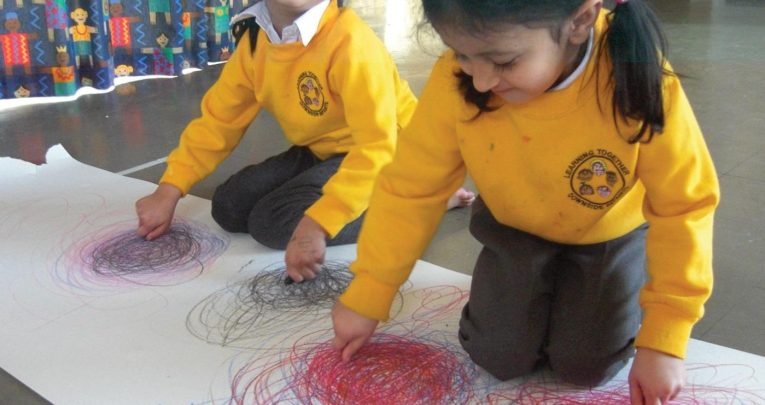3 ukulele activities to teach primary music

Liz Pichon, author of the popular Tom Gates series of books, shares some activities from the titular hero’s latest foray into the world of music…

- by Liz Pichon

The Tom Gates series has gained enormous popularity with children ages six to 12. The enthusiasm from young readers will no doubt have made the Tom Gates world familiar to parents and primary school teachers, alike.
The series follows the adventures of Tom, with his music passion for music as a backbone throughout. The original songs and lyrics that accompany the books have been a popular addition for children, and now, six of the best songs have been transcribed for learning and teaching.
The Tom Gates Music Book is interactive and provides transcriptions for ukulele, recorder, guitar, vocals and drums. Backed up with illustrations and tips and tricks, the material is easy for children to learn.
The book comes with an accompanying app, in which you play back songs and remove the lead vocals or individual instruments as desired.
This is a great classroom resource that can be used in lesson time without needing instruments – for example, assigning an activity for classmates to write their own lyrics based around a specific subject or emotion.
Once completed, pupils can then be encouraged to get up and perform in front of the class, using the app as backing track.
Teaching the material from the Tom Gates Music Book does not need to be taught solely by music teachers, although they may have preferred approaches and methods.
The following lesson plan with three suggested activities for ukulele can be taught by classroom teachers without prior experience learning an instrument or playing music.
Why ukulele?
Ukulele has replaced traditional classroom recorder learning in recent years. It’s ease of use, sound and aesthetics have made it a popular instrument with children.
Encouraging pupils to participate with music from an early age is a great way to build on confidence and further an understanding of communication and expression. Ukulele has proved to be a great tool for learners of all ages to get into music.
This suggested lesson plan can be used broadly as a template for incorporating other instruments and singing, alike.
Intro and prep
Taking a little time for preparation is key to teaching music ensemble. There may be up to thirty pupils in a class, so it’s a good idea to familiarise yourself with the chord positions and songs you would like to teach.
Prior to the lesson, take a little time to learn the chords for the song that you have decided upon. All the songs that accompany the Tom Gates music book are very easy and contain no more than three or four different chord positions. Spending 15 minutes learning chord shapes and listening to the song will make for a much more fun and efficient lesson.
It’s a good idea to ensure the Ukuleles are in tune prior to handing out to pupils. Ukuleles are tuned G-C-E-A., and using a tuner is the most simple and efficient way. If you don’t have access to a tuner, then there are plenty of resources online to help.
YouTube tutorials are a great way to learn how to tune a ukulele if you have no previous experience. Using a piano as reference for tuning is also an efficient method.
Setting some basic ground rules before noisy ensemble activities can help the lesson run a lot more smoothly. Children will feel compelled to strum their instruments from the beginning, so asking pupils to only play when instructed can save a lot of stress.
Clearing some space and seating pupils in a semi-circle is a good way to maintain a communicative and visual learning environment throughout the lesson. As you set up, you might like to play the recording of the song for pupils. This will help them get an idea of what they are about to learn.
First activity (10 minutes)
Start by introducing chord positions for your chosen song. There will only be three or four chord shapes to learn, so this keeps things simple.
Making sure pupils can see the charts for the chords they are learning is essential. It’s a good idea to highlight the chord positions on the page that are needed and backing up any extra instruction on the whiteboard.
Demonstrate how to play the chord positions with your left hand, and then execute with a single strum on your right hand. During the activity, feel free to walk around and help pupils with their chord positions. Allow a little time for learners to get to grips with each position. Then it’s time to move forward.
Second activity (20 minutes)
Once pupils are familiar with their chords, it’s time to start teaching how to switch between positions. Start by writing the chord changes up on the board, and then relating it to the music on the page. Learners should have an understanding about which chord to play in the right order.
It’s a good idea to ask learners to take things slow to begin with, then gradually speeding up their playing once they feel a little more confident. You might like to pair up pupils, which will encourage them to stay involved with the activity, and play off one another.
Halfway through the activity, try and have all the pupils in the class play in unison. For many, this will be their first try at playing music with an ensemble, so it may be a little wobbly to begin with. After a couple of run-throughs, however, you will start to hear a difference!
Third activity (20 minutes)
By now, pupils should feel confident with switching slowly between chord positions. It’s time to run though the song! Singing the lyrics along for reference can be the guiding light for pupils who don’t consider themselves that musical.
Start by counting off the song (one, two, three, four) and then playing the chord sequence, with singing, to add a sense of structure. You’ll notice that pupils will be a little unsure to start off, but the sound will build gradually throughout.
You might like to work on one section at a time, or perhaps try playing the whole thing throughout. Playing along with the recording is by no means necessary, although this can act as a great reward for pupils’ hard work.
Learning music is the experience, not the result. Some pupils will get it straight away, some will need a lot more time. The important thing is that the teaching environment is relaxed, communicative and non-judgemental.
The Tom Gates music app provides all the songs accompanying the book. Dive in and have some fun!
Accompaniments
Suggested resources to accompany a Ukulele lesson:
- Ukuleles (to be used individually or shared by pupils)
- Copies of chord charts and music from the book that you would like to teach
- Music stands, ensuring that pupils can comfortably read the material, hands free
- Access to the Tom Gates music app, to play along to the songs
- A whiteboard, used to articulate further understanding and extra references of the class
Liz Pichon is the author of The Tom Gates Music Book (£12.99, Scholastic).










